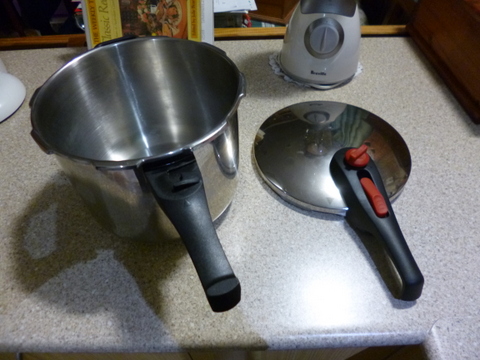Some other methods of fuel efficient cooking discussed in this section require only a small outlay on equipment, unfortunately this is not so with the pressure cooker which may cost over $200 if bought new. While I am a fan of buying second hand where possible, in the same way you would think twice about buying a second hand toothbrush, a second hand pressure cooker may not be a bargain either.
Pressure cookers operate at high pressure (the name is a dead giveaway, eh?) and while a catastrophic failure is unlikely it would certainly ruin your day if it happened. The pressure cooker in question may be being passed on due to previous problems and if you don’t absolutely know its history, give it a miss. Also, older types may not have all the safety features that the modern cookers have (ours has three separate systems to prevent overpressure) so for the sake of peace of mind, I suggest sticking with a new buy only. And read the instruction FIRST, not after all else has failed!
For the investment however, the pressure cooker does cook 66% faster than cooking at atmospheric pressure, with a subsequent saving in time, nutrients and energy, also no laborious preparation of food or equipment is required. If you are going to spend the money anyway, go for a stainless steel model, it will last you a lifetime. I don’t trust aluminium cookware generally but specifically for pressure cookers, stainless steel is much tougher and more forgiving of mistakes and rough use.
A pressure cooker works by allowing steam pressure to build up inside it to the tune of 70 to 105 kPa (10 to 15 PSI) above atmospheric pressure. At atmospheric pressure water boils at 100°C ( 212°F), no matter how long you boil it , but at 105kPa water boils at 120°C (248°F), so food can cook much more quickly. This allows the use of cheaper cuts of meat and ingredients that require longer cooking such as boiling chooks or dried beans. Dried beans can be cooked in 35 to 45 minutes in a pressure cooker and require no pre-soaking.
The main problem which can arise with pressure cookers is if the food swells up or foams up while cooking so that it blocks the pressure relief valve. To prevent this, the cooker should never be filled to more than two-thirds capacity and foods that have a tendency to foam, such as split peas, should be avoided.
It was in my mind to buy a large pressure cooker so that we could also use it for food preserving work (ie pressure canning) and while I am not sure of the where’s and why for’s, I have read that pressure cookers SHOULD NOT be used for pressure canning. So I thought I would pass that little gem of information on, so you don’t make the same mistake I did.
While they are a great way to save money, energy and nutrients if you are unfamiliar with the pressure cooker get hold of a good modern cookbook to help you through the initial stages of learning to use it.
Energy
Cooking with a Pressure Cooker
Nevin




